Angles Chapter Notes | Mathematics Class 6 ICSE PDF Download
Introduction
Angles are all around us, shaping the way we see and understand the world! From the sharp corner of a book to the wide sweep of a clock's hands, angles help us measure and describe directions and rotations. This chapter takes you on an exciting journey to explore angles, their types, how they’re named, and how we measure or even create them using simple tools. Get ready to dive into the fascinating world of angles, where lines meet to form shapes and patterns that spark curiosity!
Angle
- An angle is formed when two rays share the same starting point.
- The rays are called the arms or sides of the angle.
- The common starting point is called the vertex.
Example: Rays OA and OB start at point O. They form an angle with O as the vertex and OA, OB as the arms.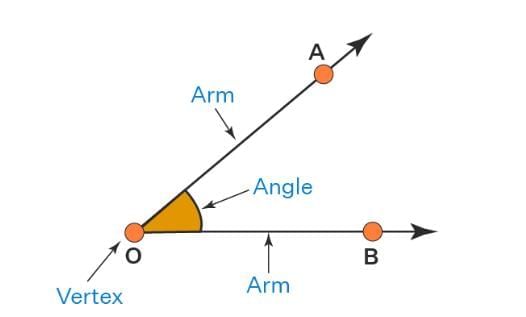
Naming of an Angle
- An angle is denoted by the symbol ∠.
- It can be named using three letters, with the middle letter as the vertex (e.g., ∠AOB or ∠BOA).
- It can also be named using just the vertex (e.g., ∠O).
- Angles can be labeled with numbers (e.g., ∠1, ∠2) or small letters (e.g., ∠a, ∠b).
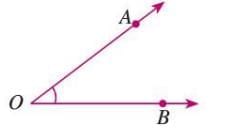
Example: In a figure, ∠O can also be written as ∠POS, ∠POR, ∠QOR, or ∠QOS, depending on the points on the rays.
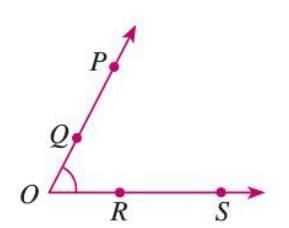
Points to Remember:
- In a three-letter name like ∠ABC, the middle letter (B) is always the vertex.
- An angle can have multiple names based on points along its arms.
Interior and Exterior of an Angle
- The area between the two arms of an angle is called its interior.
- The area outside the arms is called the exterior.
- The arms themselves form the boundary of the angle.
- Any point in a plane is either inside, outside, or on the boundary of the angle.
Example: In ∠AOB, the shaded region between arms OA and OB is the interior, the white region outside is the exterior, point P is inside, point Q is outside, and points A, R, O, B, S are on the boundary.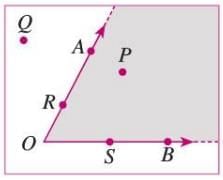
Points to Remember:
- The interior and exterior extend endlessly as the rays go on infinitely.
- The arms separate the interior from the exterior.
Magnitude of an Angle
- The size of an angle is its magnitude, measured by how much one arm rotates around the vertex to meet the other arm.
- The unit of measurement is degrees, denoted by °.
Example: In ∠PQR, the magnitude is the rotation needed for arm QR to align with arm QP.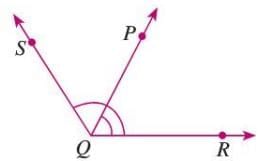
Types of Angles
Angles are classified based on their magnitude.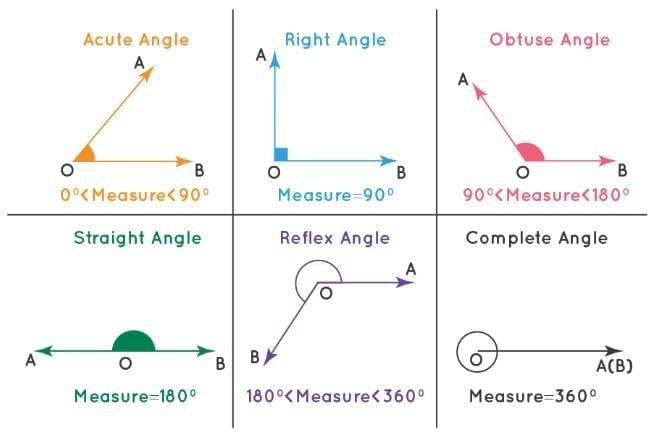
Acute Angle
- An angle measuring more than 0° but less than 90°.
Example: Angles like 15°, 30°, or 45° are acute angles.
Right Angle
- An angle measuring exactly 90°.
Example: An angle of 90° is a right angle, like the corner of a square.
Obtuse Angle
- An angle measuring more than 90° but less than 180°.
Example: Angles like 96°, 118°, or 175° are obtuse angles.
Straight Angle
- An angle measuring exactly 180°.
Example: An angle of 180° forms a straight line.
Reflex Angle
- An angle measuring more than 180° but less than 360°.
Example: Angles like 188°, 220°, or 350° are reflex angles.
Points to Remember:
- Lines, rays, or segments forming a right angle are perpendicular.
- The sum of angles around a point is always 360°.
- Formula: ∠AOB + ∠BOC + ∠COD + ∠DOA = 360°.
Some Special Angles
Zero Angle

- An angle where the ray doesn’t rotate, so the magnitude is 0°.
Example: If a ray’s initial and final positions are the same without rotation, it forms a 0° angle.
Complete Angle
- An angle formed by one full rotation of a ray, measuring 360°.
Example: If ray OA rotates fully and returns to its starting position, it forms a 360° complete angle.
Special Pairs of Angles
Congruent Angles
- Angles with the same magnitude are congruent.
Example: If ∠ABC = 30° and ∠MNO = 30°, they are congruent angles.
Vertically Opposite Angles
- Angles formed by two intersecting lines with no common arm.
- They are always equal.
Example: If two lines intersect, ∠m = ∠n and ∠x = ∠y are vertically opposite angles.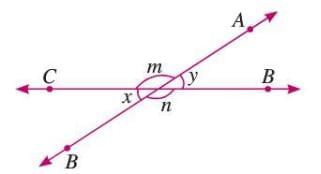
Complementary Angles
- Two angles whose measures add up to 90°.
- Formula: ∠A + ∠B = 90°.
Example: If ∠ABC = 60° and ∠PQR = 30°, then 60° + 30° = 90°, so they are complementary.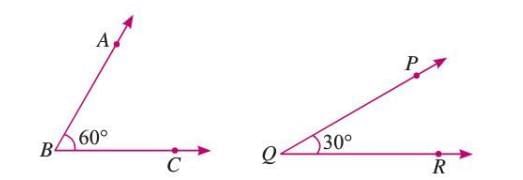
Supplementary Angles
- Two angles whose measures add up to 180°.
- Formula: ∠A + ∠B = 180°.
Example: If ∠ABC = 120° and ∠PQR = 60°, then 120° + 60° = 180°, so they are supplementary.
Adjacent Angles
- Two angles sharing a common arm and vertex, lying on opposite sides of the common arm.
Example: ∠AOB and ∠BOC are adjacent angles with OB as the common arm and O as the vertex.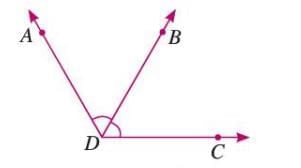
Linear Pair
- Two adjacent angles that are supplementary (sum to 180°).
- Formula: ∠A + ∠B = 180° (where ∠A and ∠B are adjacent).
Example: ∠AOC and ∠BOC are adjacent and sum to 180°, forming a linear pair.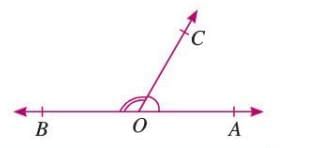
Measurement of a Line Segment
- A line segment’s length can be measured using two methods:
By Ruler
- Place the ruler’s 0 mark at one end of the segment.
- Align the ruler along the segment.
- Read the mark where the other end of the segment falls.
- Units are usually centimeters (cm) or millimeters (mm).
Example: For line segment AB, align the ruler with 0 at A, and read the mark at B. If it’s 4 cm, then AB = 4 cm.
By Divider and Ruler
- Place one end of the divider at point A and adjust it to reach point B.
- Keep the divider’s opening fixed and place it on the ruler with one end at 0.
- Read the ruler mark where the other end of the divider falls.
Example: For line segment AB, set the divider from A to B, then place it on a ruler. If the ruler shows 4 cm, then AB = 4 cm.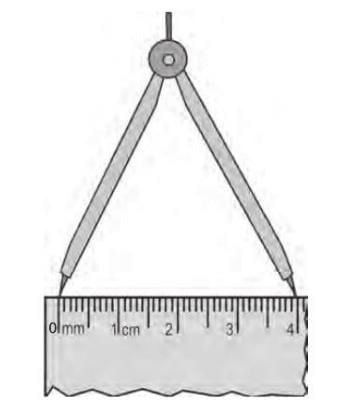
Why Divider is Better: Using a divider and ruler reduces errors from angular viewing, unlike using a ruler alone.
Measurement of an Angle
- Angles are measured in degrees (°).
- One complete rotation around a point is 360°.
- 1° is divided into 60 minutes (′), and 1 minute is divided into 60 seconds (″).
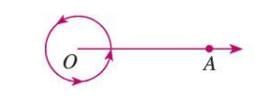
Formulas:
- 1 complete rotation = 360°
- 1° = 60′
- 1′ = 60″
Example: Find the angle that is 10°15′30″ smaller than 120°10′50″.
Solution:
- Subtract: 120°10′50″ − 10°15′30″
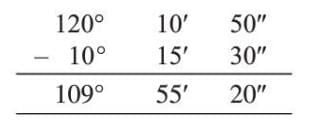
- Degrees: 120° − 10° = 110°
- Minutes: 10′ − 15′ = −5′ (borrow 1° = 60′)
- Degrees become: 110° − 1° = 109°, Minutes: 60′ + 10′ − 15′ = 55′
- Seconds: 50″ − 30″ = 20″
- Result: 109°55′20″
Use of Protractor to Measure an Angle
- A protractor is a tool for measuring and constructing angles.
- It has a circular scale marked from 0° to 180°.
- Inner scale measures angles in the anticlockwise direction.
- Outer scale measures angles in the clockwise direction.
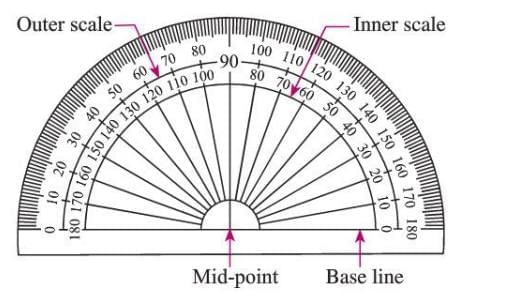
Steps to Measure:
- Place the protractor’s midpoint on the angle’s vertex.
- Align the base line with one arm (ray).
- Read the degree mark where the other arm falls on the appropriate scale.
- Use the inner scale for angles opening to the right, outer scale for angles opening to the left.
Example: To measure ∠AOB, place the protractor’s midpoint on O.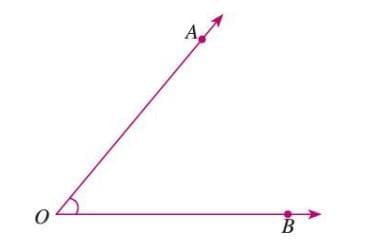 Align the base with ray OB, and read the inner scale where ray OA falls. If it’s 50°, then ∠AOB = 50°.
Align the base with ray OB, and read the inner scale where ray OA falls. If it’s 50°, then ∠AOB = 50°.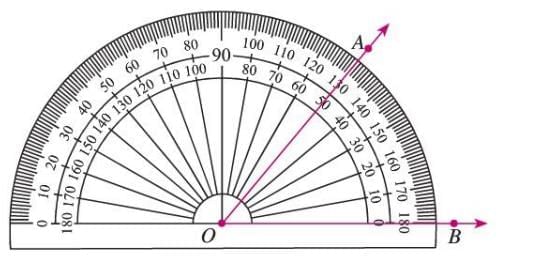
Solved Example: Measure ∠PQR, where the arc is on the outer side (reflex angle).
Solution:
- Place the protractor’s midpoint on Q, base on ray QR.
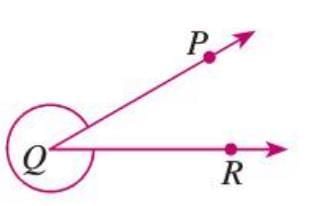
- Use the outer scale (since the arc is outer) to measure ∠PQR = 30°.
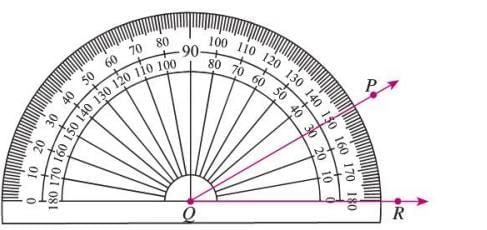
- For reflex angle: 360° − 30° = 330°.
Use of Protractor to Construct an Angle
Steps to Construct:
- Draw a ray (e.g., OP) with starting point O.

- Place the protractor’s midpoint on O, align the base with ray OP.
- Use the inner scale (for angles opening right) and mark the desired degree (e.g., 36°).
- Remove the protractor and draw a ray from O to the marked point (Q).
- The angle formed (e.g., ∠POQ) is the required angle.
- For reflex angles (>180°), construct the smaller angle (360° − desired angle) and mark the outer arc.
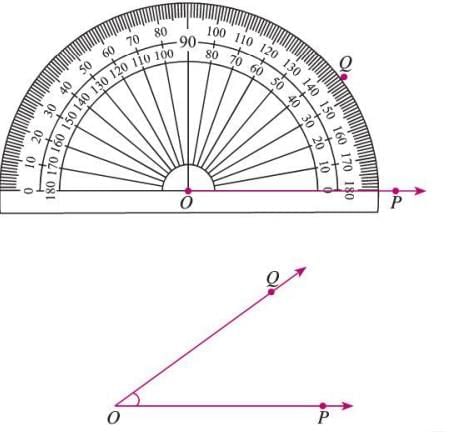
|
44 videos|201 docs|24 tests
|
FAQs on Angles Chapter Notes - Mathematics Class 6 ICSE
| 1. What is an angle and how is it formed? |  |
| 2. How do you name an angle? |  |
| 3. What are the different types of angles? |  |
| 4. What is the difference between interior and exterior angles? |  |
| 5. How do you measure an angle? |  |
















